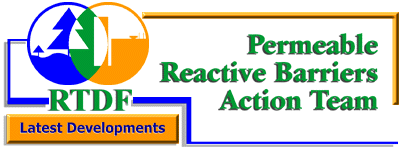 |
|
||||||
|
|
|
||||||
|
|
|||||||
 |
|
||||||
|
|
|
||||||
|
|
|||||||
|
Contaminants: Reactive Media: Construction: Point of Contact: |
|
|
This permeable reactive barrier (PRB) system was installed at the property boundary of an industrial site in Coffeyville, KS, in January 1996. The site covers about 200 acres and is hydrologically and geochemically complex. Contaminants include trichloroethylene (TCE) and 1,1,1-trichloroethane (TCA). Prior releases at this site had generated a dissolved plume approximately 875 yds long contaminated with 400 µg/L of TCE and 100 µg/L of 1,1,1-TCA. Contaminant transport occurred to the greatest lateral extent in a basal sand and gravel unit just above shale bedrock, which lies about 30 ft beneath the site. There is nearby public use of shallow ground water necessitating measures to prevent additional off site migration. Shale bedrock located about 30 ft below the ground surface is overlain by sand and gravel unit. No Information. The PRB system uses a funnel-and-gate configuration to direct ground water through a single, permeable treatment gate that is 20 ft long and 3 ft thick. The funnel section of the system consists of two 490-ft soil-bentonite slurry walls on either side of the treatment gate. Zero-valent iron is used as the reactive material. The treatment wall contains 70 tons of the iron. A low ground-water flow velocity of 0.2 ft/day permitted the use of this relatively high funnel-to-gate ratio. The system is installed to a depth of 30 ft in a basal alluvial aquifer. No determinations of ground-water velocity through the system have been made to date. Concentrations in the iron zone are below Maximum Contaminant Levels (MCLs). |
![]()
Sponsored by the Technology Innovation Program
Date Last Modified: January 14, 2000